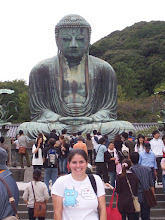We had been hearing about this parade for weeks. "Go to the Mikoshi parade," they told us in our class, "get some Japanese culture."
A Mikoshi, our instructor explained, is a portable shrine. Many people lend a shoulder to help carry it. The base would sponsor its own Mikoshi and the parade would come on base for us to watch.
Okay, but we wanted to see the Japanese festival not the American version of the Japanese festival. So we left early in the morning to stake out a corner of Blue Street from which to watch. Blue street is the main street in Yokosuka and it was being closed to all traffic. This parade was a big deal.
Hours before the parade was set to start, even we foreigners could tell something was different on blue street. Vendors had set up little stands from which they sold food and small toys. One even had a long tank full of goldfish.
We saw a lot of Japanese people, both men and women, dressed like this.

The man pictured below carrying the tall staff with tassels is the leader of the parade.

Behind him came squads of Japanese men, woman and children dragging Mikoshi on carts.
 We happened to be standing near the staging area so we got the interesting experience of watching the squads lifting the Mikoshi from the carts to their shoulders. I could explain the process, but the video below will be much more eloquent.
We happened to be standing near the staging area so we got the interesting experience of watching the squads lifting the Mikoshi from the carts to their shoulders. I could explain the process, but the video below will be much more eloquent.People crushed in on all sides. I was pressed between a middle-age Japanese man and a group of old Japanese women. Personal space is not something people in Japan think about. I had never seen sidewalks so crowded. People trying to move up or down the street had to walk single file and fight for every step.
The man beside me spoke English competently so our group relied on him to explain the situation. He saw me taking picture after picture and said "This will take many picture."
I nodded.
He continued, "There are 74 Mikoshi."
"74?" I repeated, not certain I had understood him correctly.
This time he nodded. "Yes, 74."
"Wow," I said. What else was there to say?
As each Mikoshi got moving the squad leader did a little chant to keep time for the shuffle-jump dance they did. Each chant was a little different. Just as each shrine was a little different. Some carried drummers or flutists.
 Others bore masked beasts who moved like paper dragons.
Others bore masked beasts who moved like paper dragons. The Mikoshi represent real, full-size Shinto shrines all over Japan. Parading through the streets with them allows all Japanese to visit the shrines even if they are unable to travel. And it honors the gods of each shrine.
The Mikoshi represent real, full-size Shinto shrines all over Japan. Parading through the streets with them allows all Japanese to visit the shrines even if they are unable to travel. And it honors the gods of each shrine.The video below shows a particularly extravagant dance. I think it was supposed to symbolize the sea.
It was almost scary to watch because the people on either side of the street would gasp and cry out. I was afraid the whole thing would topple and the shrine would end up in a thousand pieces on the street. Happily, that never happened.
I was taking so many pictures that my camera ran out of batteries half way through the parade. I ducked into a pharmacy and bought some more. If you want to see more of the pictures I took, copy and paste this link http://picasaweb.google.com/read.read.rose/MikoshiParade.
My camera made me at least one friend. This girl grinned at me when she saw a camera pointed in her direction. She flashed a peace sign, as all Japanese children and teens do when you threaten to photograph them, but she seemed to know the redundancy of her gesture because she quickly dropped it and just smiled instead.

This little boy impressed us all. He was actually riding on the front of the Mikoshi wearing nothing but a loincloth. The Japanese have a slightly different standard of decency that we do in the states.

When we got tired of the crowds and the noise we headed back toward base. On the way, we couldn't help but stop for some snacks. This is me with my chocolate covered banana on a stick.
Back on base, we stopped to take a picture of the Base Mikoshi which was just then moving past McDonald's. 
I leave you today with a quote from W. Beran Wolfe "If you observe a really happy man, you will find...that he is happy in the course of living twenty-four crowded hours each day."






